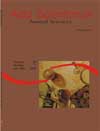Exigências nutricionais de cálcio e fósforo para codornas japonesas (<em>Coturnix coturnix japonica</em>) em postura
Resumo
Com o objetivo de determinar as exigências nutricionais de cálcio (Ca) e fósforo (P) para codornas japonesas (Coturnix coturnix japonica) em postura, utilizaram-se 512 codornas, em esquema fatorial 4x4 (níveis de P (disponível) - 0,27%, 0,32%, 0,37% e 0,42% e níveis de Ca-2,5%, 3,0%, 3,5% e 4,0%), com quatro repetições e oito codornas por unidade experimental. Houve interação linear (p < 0,05) entre os níveis de Ca e P para % de postura, em que o nível de P que maximizou a interação foi de 0,36%, e o nível de Ca de 3,06%. O aumento dos níveis de Ca diminuiu linearmente (p < 0,01) o consumo de ração e o peso dos ovos, e aumentou a % de casca nos ovos (p < 0,01) e a resistência da tíbia (p < 0,05). O aumento dos níveis de P melhorou linearmente (p < 0,05) a conversão alimentar (kg/dz) e observou-se efeito quadrático (p < 0,05) para o consumo de ração, conversão alimentar (kg/kg), % de casca e de P nos ossos, sendo os níveis ótimos de: 0,36%, 0,36%, 0,37% e 0,35%, respectivamente. Conclui-se que as exigências nutricionais para codornas japonesas em postura são de 2,5% de Ca e 0,36% de P.Downloads
DECLARAÇÃO DE ORIGINALIDADE E DIREITOS AUTORAIS
Declaro que o presente artigo é original, não tendo sido submetido à publicação em qualquer outro periódico nacional ou internacional, quer seja em parte ou em sua totalidade.
Os direitos autorais pertencem exclusivamente aos autores. Os direitos de licenciamento utilizados pelo periódico é a licença Creative Commons Attribution 4.0 (CC BY 4.0): são permitidos o compartilhamento (cópia e distribuição do material em qualqer meio ou formato) e adaptação (remix, transformação e criação de material a partir do conteúdo assim licenciado para quaisquer fins, inclusive comerciais.
Recomenda-se a leitura desse link para maiores informações sobre o tema: fornecimento de créditos e referências de forma correta, entre outros detalhes cruciais para uso adequado do material licenciado.








































